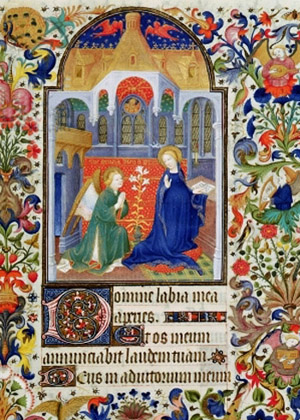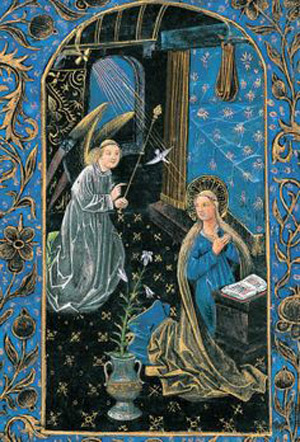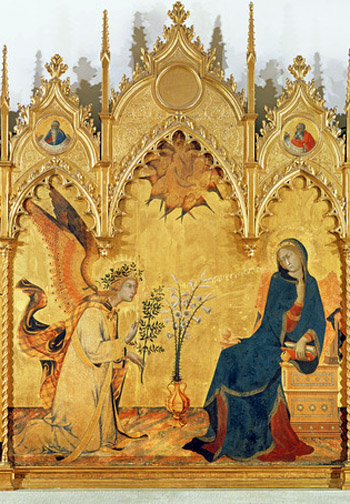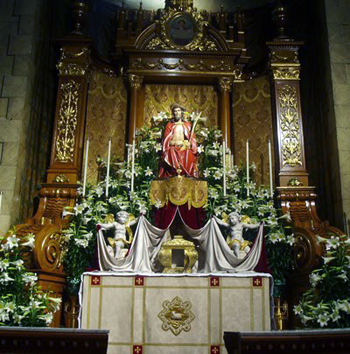The Lily: Symbol of the Annunciation
& the Resurrection
Marian T. Horvat, Ph.D.
The Easter lily, rich in symbolism
This year, when Easter falls early on March 27, so near the Feast of the Annunciation, it seems appropriate to look at the symbolism of the lily. For this flower is a symbol connected to both the Annunciation of Our Lady and Our Lord's Resurrection.
A symbol of Our Lady's purity & innocence
As early as the 7th century, the Ven. Bede (673-735) likened the Virgin
Mary to a white lily, the white petals symbolizing her pure virginal
body and the golden anthers the radiance of her soul.

A symbolic pot of lilies between the Archangel & Our Lady, below, Gabriel holds a lily in his hand
 We find reference again to Our Lady's purity when the great St. Bernard
(1090-1154) described Our Lady as "the violet of humility, the lily of
chastity, the rose of purity."
We find reference again to Our Lady's purity when the great St. Bernard
(1090-1154) described Our Lady as "the violet of humility, the lily of
chastity, the rose of purity."
The Church taught the Annunciation took place in the springtime "at the
time of the flowers." Also, according to the scholars of St. Bernard’s
time, the name Nazareth in Hebrew signifies a flower. Thus, he would
write: "The flower willed to be born of a flower, in a flower, at the
time of flowers" (Flos nasci voluit de flore, in flore et floris tempore)." (1)
The flower the medievals found to best symbolize the purity of Mary, a virgin ante partum, in partu et post partem,
was the lily, admired as a flower of purity since the time of the
Ancients. Thus, by the 14th century, it became common to find the lily
in Annunciation paintings and illuminations. Between the Angel Gabriel
and the young Virgin at prayer is the vase with the lily. In many scenes
of the Annunciation painted during the Renaissance, the Archangel
Gabriel holds a lily.
Beautiful legends emerged to explain the origin of the flower. It was
told that the lily sprang from the tears of Eve, when she was expelled
from the Garden of Eden. But it was yellow until the day that the Virgin
Mary stooped to pick it, thus symbolizing the role of the New Eve in
restoring to the world the innocence lost by Eve. (2)
The legends also tell of a Jew and Catholic who were sitting together
between a wine pot arguing about the perpetual virginity of Our Lady.
The Catholic said to the Jew, "We believe that just as the
stalk of the lily grows and conceives the color of green, and afterwards
brings forth a white flower without the craft of man or any impairing
of the stalk, in that way also Our Lady conceived of the Holy Ghost and
afterwards brought forth her Son without blemish of her body, He Who is
the flower and chief fruit of all men."
The Jew replied, "When I see a lily spring out of this pot, I will believe and not before."
Then, forthwith a lily sprang out of the pot, the fairest that ever was
seen. And when the Jew saw that, he fell down on his knees and said,
"Lady, now I believe that thou conceived of the Holy Ghost Jesus
Christ, God's Son of Heaven, and remained a clean maiden before and
after."
And so the Jew was baptized and became a pious man.

It became traditional to place a pot of lilies between the Archangel and Our Lady
For this reason, the legend closes, the pot and the lily is set between
Our Lady and Gabriel: "For just as this Jew disputed with the Catholic
over the manner of the conception of Our Lady, thus did Our Lady herself
question the Angel about the manner and way she should conceive and
remain a maiden before and after." (3)
By a similar miracle involving a lily, a pious Dominican monk was cured of his doubt of the Madonna's virginal motherhood.
This monk had turned to St. Aegidius to relieve the misgiving in his
soul. St. Aegidius removed his doubt without a waste of words.
He merely struck the earth with his staff, and immediately a lily sprang
up as a sign of Our Lady's virginity before Our Lord’s birth. Then he
struck it a second time with his staff, and another lily arose as
evidence of her virginity in His birth. A third striking with the words "Virgo post partum" brought forth the third lily, confirming Holy Mary's virginity after His birth. (4)
Recalling this great miracle, some artists of medieval Annunciation pictures painted three blossoms on a single stem.
Thus, Mary came to be associated not only with the rose, but the lily
because it is white, untouched and noble. The lily was also reputed
among the ancients to have the power of healing, and so in this too
corresponded to the Woman who was bring to the world the cure for its
sins.

A symbolic pot of lilies between the Archangel & Our Lady, below, Gabriel holds a lily in his hand


It became traditional to place a pot of lilies between the Archangel and Our Lady
Related:
http://tradcatknight.blogspot.com/2015/09/what-is-symbol-of-nobility-and-power.html
http://tradcatknight.blogspot.com/2015/07/the-sacred-heart-of-jesus-symbol-of.html
http://tradcatknight.blogspot.com/2014/08/knowing-saints-by-their-emblems.html
The Easter lily
According to a pious legend, after the Death and Resurrection of Our
Lord, some of these beautiful flowers were found growing in the Garden
of Gethsemane, where Jesus went to pray the night before His
Crucifixion. Legend has it that these flowers sprung up where drops of
Christ's blood fell as he prayed." Thus, they are called the "white
robed apostles of hope." (5)
In the Middle Ages and the Renaissance, however, it was not common to
see the lily in Resurrection paintings. Instead, Christ is almost
invariably shown rising from a tomb from which the stone has already
been removed.

Ester lilies are a familiar sight on altars at Easter
The old masters had a reason for this: They wished to portray the deep
significance attached by the Fathers to the removal of the stone. The
stone before the tomb was a symbol of the table of stone on which the
Ancient Law was written – it is the Ancient Law itself. In the Old
Testament the spirit was hidden beneath the letter as Christ was hidden
beneath the stone. When He rose from the dead, the Law no longer had any
meaning.
It was only in the early 1900s that the lily became a common adornment
in churches and homes in the Paschal season and began to be commonly
used in Resurrection paintings and depictions. Truly, the flower lends
itself readily as a fitting symbol of the Resurrection.
The seemingly lifeless bulb buried in the ground represents the tomb of
Christ; from the cold earth new life is released, recalling Christ
rising from the dead. Like Christ, the Easter lily is reborn to live
again.
This glorious white trumpet-like flower symbolizes His life after death.
The snowy white color stands for the purity of the Divine Savior, the
gold represents his Kingship, while the trumpet shape signifies
Gabriel's trumpet call to rebirth and new life.
Thus, the flower known as the Easter Lily has become a symbol of
Christ’s Resurrection and the same flower, also known as the Madonna
Lily, represents the Annunciation.

Ester lilies are a familiar sight on altars at Easter
